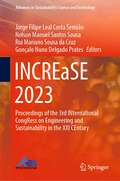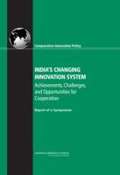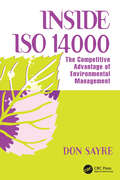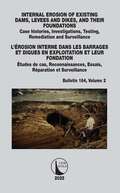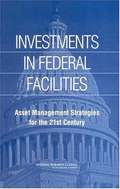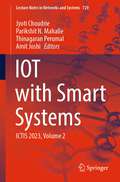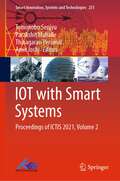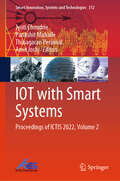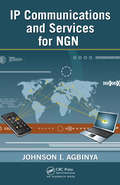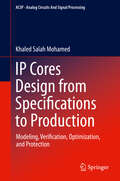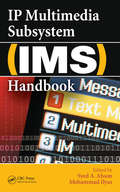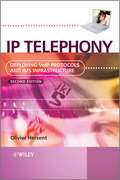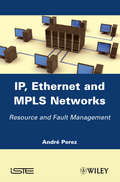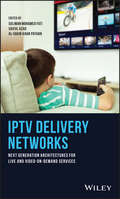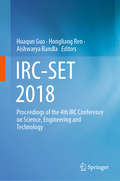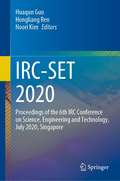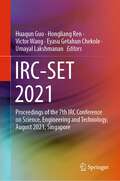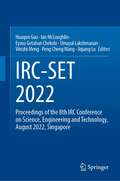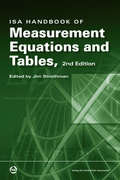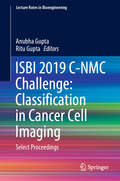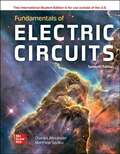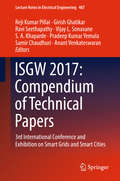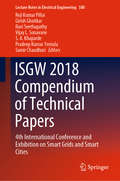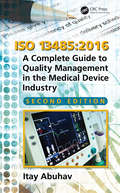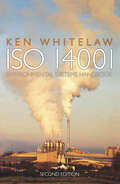- Table View
- List View
INCREaSE 2023: Proceedings of the 3rd INternational CongRess on Engineering and Sustainability in the XXI CEntury (Advances in Sustainability Science and Technology)
by Jorge Filipe Leal Costa Semião Nelson Manuel Santos Sousa Rui Mariano Sousa da Cruz Gonçalo Nuno Delgado PratesThis book includes the proceedings of the 3rd International Congress on Engineering and Sustainability in the XXI CEntury, INCREaSE 2023. INCREaSE is a congress with the aim to bring together valuable and novel scientific contributions that address the critical issues of renewable energy, sustainable building, sustainable manufacturing, sustainable food production and other sustainability science and engineering topics that have an impact in this diverse and fast-changing research area, both in academia and industry. This 3rd edition of INCREaSE was held during July 5-7, 2023, in Faro, Portugal, organized by the Institute of Engineering and hosted by University of Algarve. The areas to be covered were:• Big data and data analytics applied to sustainability;• Climate change and mitigation, carbon reduction;• Combined heat and power and district heating systems;• Control and optimization of renewable energy systems;• Energy and environmental assessment in buildings and cities;• Food loss and food waste solutions;• Food safety and quality engineering;• Information technology and artificial intelligence applied to sustainability;• Nanoelectronic, nanomachining, and new nanomaterials;• Smart buildings, smart cities, smart districts, smart countryside;• Sustainability in water management;• Sustainable building technologies;• Sustainable development and circular economy;• Sustainable energy generation and management;• Sustainable food processing and packaging;• Sustainable manufacturing and maintenance processes and technology;• Sustainable technologies for risk mitigations;• Sustainable transport, smart vehicles and smart roads; and• Thermo fluids modelling and experiments for sustainability. High quality and unpublished content is an essential feature for all included papers. Moreover, the Organizing Committee of the conference guarantees that contributions were subjected to an appropriate level of reviewing process.
INDIA'S CHANGING INNOVATION SYSTEM: Achievements, Challenges, and Opportunities for Cooperation
by National Research Council of the National AcademiesAs part of its review of Comparative Innovation Policy: Best Practice for the 21st Century, the Board on Science, Technology, and Economic Policy (STEP) convened a symposium in 2006 to examine the policy changes that have contributed to India's enhanced innovative capacity. Convening leaders from the public and private sectors in India and the U.S., the symposium identified accomplishments and existing challenges in the Indian innovation system and reviewed opportunities for enhanced cooperation between the two countries. This report summarizes the symposium presentations, along with an introductory analysis of policy issues raised at the symposium and a research paper examining India’s knowledge economy.
INSDE ISO 14000: The Competitive Advantage of Environmental Management
by Donald Alford SayreThe International Organization for Standardization (ISO) has a master scheme in mind for the protection and preservation of the environment, for sustainable development of life and improving the ecosystem. They call it ISO 14000, the standard and guidelines for effective environmental management systems.Inside ISO 14000 does what its title sugg
INTERNAL EROSION OF EXISTING DAMS, LEVEES AND DIKES, AND THEIR FOUNDATIONS / L’ÉROSION INTERNE DANS LES BARRAGES ET DIGUES EN EXPLOITATION ET LEUR FONDATION: Case histories, Investigations, Testing, Remediation and Surveillance / Études de cas, Reconnaissances, Essais, Réparation et Surveillance (ICOLD Bulletins Series)
by CIGB ICOLDICOLD Bulletin 164 Volume 2 presents case histories of internal erosion failures and incidents, and advises on the investigations, sampling and testing that can be used to provide the data needed to carry out analyses of the vulnerability of dams and levees to internal erosion. It also advises on remediation, if analyses have demonstrated that it is necessary, and on surveillance and monitoring systems to check and confirm the continuing ability of the dam to resist internal erosion in the long-term.The Working Group on Internal Erosion has brought together experts from all continents at annual meetings and their work provides the basis for most of Volume 2. Information on case histories has been most generously provided by owners and engineers, recognizing that such information will contribute to preventing tragic events in future. The work of specialists in laboratory testing and geophysics who have contributed actively to the Working Group over many years is now accessible to dam engineers in the chapters on investigations and monitoring in ICOLD Bulletin 164 Volume 2.Le ICOLD Bulletin 164 Volume 2 présente des cas de ruptures et d'incidents par érosion interne et donne des conseils sur les reconnaissances, les prélèvements et les essais qui peuvent fournir les données nécessaires à l'analyse de la tenue des barrages et digues à l'érosion interne. Il donne également des conseils sur les mesures correctives, quand elles sont jugées nécessaires par l’évaluation du risque d’érosion interne, et sur les systèmes de surveillance et de contrôle permettant de vérifier et de confirmer la capacité permanente du barrage à résister à l'érosion interne à long terme. Le groupe de travail sur l'érosion interne a réuni des experts de tous les continents et leurs travaux constituent la base de la majeure partie du volume 2. Les maîtres d'ouvrage et les ingénieurs ont généreusement fourni des informations sur les études de cas, reconnaissant que ces informations contribueront à prévenir à l'avenir de tels événements tragiques. Le travail des géotechniciens et des géophysiciens, qui ont activement contribué au groupe de travail pendant de nombreuses années, est maintenant accessible aux ingénieurs des barrages dans les chapitres du ICOLD Bulletin 164 Volume 2 sur les reconnaissances et la surveillance.
INVESTMENTS IN FEDERAL FACILITIES: Asset Management Strategies for the 21st Century
by Committee on Business Strategies for Public Capital InvestmentFacilities now owned by the Federal Government are valued at over $300 billion. It also spends over $25 billion per year for acquisition, renovation, and upkeep. Despite the size of these sums, there is a growing litany of problems with federal facilities that continues to put a drain on the federal budget and compromise the effectiveness of federal services. To examine ways to address these problems, the sponsoring agencies of the Federal Facilities Council (FFC) asked the National Research Council (NRC) to develop guidelines for making improved decisions about investment in and renewal, maintenance, and replacement of federal facilities. This report provides the result of that assessment. It presents a review of both public and private practices used to support such decision making and identifies appropriate objectives, practices, and performance measures. The report presents a series of recommendations designed to assist federal agencies and departments improve management of and investment decision making for their facilities.
IOT with Smart Systems: ICTIS 2023, Volume 2 (Lecture Notes in Networks and Systems #720)
by Amit Joshi Jyoti Choudrie Parikshit N. Mahalle Thinagaran PerumalThis book gathers papers addressing state-of-the-art research in all areas of information and communication technologies and their applications in intelligent computing, cloud storage, data mining and software analysis. It presents the outcomes of the Seventh International Conference on Information and Communication Technology for Intelligent Systems (ICTIS 2023), held in Ahmedabad, India. The book is divided into two volumes. It discusses the fundamentals of various data analysis techniques and algorithms, making it a valuable resource for researchers and practitioners alike.
IOT with Smart Systems: Proceedings of ICTIS 2021, Volume 2 (Smart Innovation, Systems and Technologies #251)
by Amit Joshi Tomonobu Senjyu Thinagaran Perumal Parakshit MahalleThis book gathers papers addressing state-of-the-art research in all areas of information and communication technologies and their applications in intelligent computing, cloud storage, data mining and software analysis. It presents the outcomes of the Fifth International Conference on Information and Communication Technology for Intelligent Systems (ICTIS 2021), held in Ahmedabad, India. The book is divided into two volumes. It discusses the fundamentals of various data analysis techniques and algorithms, making it a valuable resource for researchers and practitioners alike.
IOT with Smart Systems: Proceedings of ICTIS 2022, Volume 2 (Smart Innovation, Systems and Technologies #312)
by Amit Joshi Jyoti Choudrie Parikshit Mahalle Thinagaran PerumalThis book gathers papers addressing state-of-the-art research in all areas of information and communication technologies and their applications in intelligent computing, cloud storage, data mining and software analysis. It presents the outcomes of the Sixth International Conference on Information and Communication Technology for Intelligent Systems (ICTIS 2022), held in Ahmedabad, India. The book is divided into two volumes. It discusses the fundamentals of various data analysis techniques and algorithms, making it a valuable resource for researchers and practitioners alike.
IP Communications and Services for NGN
by Johnson I AgbinyaRapid deployment and acceptance of broadband networks, including the 802.11 a/b/g, 3G cellular networks, WiMAX, and emerging 4G cellular IP networks, have sparked a growing reliance on voice over IP and the quickly emerging IP TV and Mobile TV. Providing the necessary background and technical understanding to stay abreast of and even ahead of the IP trend, IP Communications and Services for NGN explores IP development for the delivery of next generation mobile services. Packed with detailed illustrations, this cutting-edge reference examines the primary IP protocols (IPv4 and IPv6), real-time protocols, and three major IP services (VoIP, IPTV, and Mobile TV). It clearly explains the different architectures of fixed, mobile, and wireless networks along with the major advantages and disadvantages of each. It includes coverage of the latest in:The VoIP MarketSCTP and Vertical HandoffRSVP: Resource Reservation ProtocolMPLS: MultiProtocol Label SwitchingSIP: Session Initiation ProtocolIMS: IP Multimedia SubsystemRTSP: Real-Time Streaming ProtocolRTP: Real-Time Transport ProtocolIPTV System Architectures and IPTV System DescriptionsWith a detailed listing of commonly used acronyms, along with a clear description of the role IP is likely to play in the development of next generation mobile services, this book provides educators, industry practitioners, regulators, and subscribers with the ideal starting point for developing the understanding required to deploy, train, and use IP services effectively and efficiently.
IP Cores Design from Specifications to Production
by Khaled Salah MohamedThis book describes the life cycle process of IP cores, from specification to production, including IP modeling, verification, optimization, and protection. Various trade-offs in the design process are discussed, including those associated with many of the most common memory cores, controller IPs and system-on-chip (SoC) buses. Readers will also benefit from the author's practical coverage of new verification methodologies. such as bug localization, UVM, and scan-chain. A SoC case study is presented to compare traditional verification with the new verification methodologies. Discusses the entire life cycle process of IP cores, from specification to production, including IP modeling, verification, optimization, and protection; Introduce a deep introduction for Verilog for both implementation and verification point of view. Demonstrates how to use IP in applications such as memory controllers and SoC buses. Describes a new verification methodology called bug localization; Presents a novel scan-chain methodology for RTL debugging; Enables readers to employ UVM methodology in straightforward, practical terms.
IP Multimedia Subsystem (IMS) Handbook
by Mohammad Ilyas Syed A. AhsonTake Part in the Future of Wireless/Wireline Convergence The IP multimedia subsystem (IMS), established as the foundation for future wireless and wireline convergence, is the bedrock that will facilitate easy deployment on new, rich, personalized multimedia communication services that mix telecom and data services. Designers, planners, and researchers of communication systems will need to make full use of the technology occurring with this convergence if they want to be the ones providing end users with new and efficient services that are as cost-effective as they are innovative. To provide researchers and technicians with the tools they need to optimize their role in this communication revolution, the IP Multimedia Subsystem (IMS) Handbook presents all the technical aspects of the IMS needed to support the growth of digital traffic and the implementation of underlying networks. This guide covers everything from basic concepts to research-grade material, including the future direction of the architecture. Organized in three sections, the book brings together the technical savvy of 50 pioneering experts from around the world, providing complete coverage of relevant concepts, technologies, and services. Learn How IMS Will Speed InnovationFilling the gap between existing traditional telecommunications and Internet technologies, IMS has led to an environment in which new services and concepts are introduced more quickly than ever before, such as reusable service components and real-time integration. The technology promises to be a cost-effective evolutionary path to future wireless and wireline convergences that will meet next-generation service requirements.
IP Telephony
by Olivier HersentAll you need to know about deploying VoIP protocols in one comprehensive and highly practical reference - Now updated with coverage on SIP and the IMS infrastructureThis book provides a comprehensive and practical overview of the technology behind Internet Telephony (IP), providing essential information to Network Engineers, Designers, and Managers who need to understand the protocols. Furthermore, the author explores the issues involved in the migration of existing telephony infrastructure to an IP - based real time communication service. Assuming a working knowledge of IP and networking, it addresses the technical aspects of real-time applications over IP. Drawing on his extensive research and practical development experience in VoIP from its earliest stages, the author provides an accessible reference to all the relevant standards and cutting-edge techniques in a single resource.Key Features:Updated with a chapter on SIP and the IMS infrastructure Covers ALL the major VoIP protocols - SIP, H323 and MGCP Includes a large section on practical deployment issues gleaned from the authors' own experience Chapter on the rationale for IP telephony and description of the technical and business drivers for transitioning to all IP networks This book will be a valuable guide for professional network engineers, designers and managers, decision makers and project managers overseeing VoIP implementations, market analysts, and consultants. Advanced undergraduate and graduate students undertaking data/voice/multimedia communications courses will also find this book of interest.Olivier Hersent founded NetCentrex, a leading provider of VoIP infrastructure for service providers, then became CTO of Comverse after the acquisition of NetCentrex. He now manages Actility, provider of IMS based M2M and smartgrid infrastructure and applications.
IP, Ethernet and MPLS Networks: Resource and Fault Management
by André PérezThis book summarizes the key Quality of Service technologies deployed in telecommunications networks: Ethernet, IP, and MPLS. The QoS of the network is made up of two parts: fault and resource management. Network operation quality is among the functions to be fulfilled in order to offer QoS to the end user. It is characterized by four parameters: packet loss, delay, jitter or the variation of delay over time, and availability. Resource management employs mechanisms that enable the first three parameters to be guaranteed or optimized. Fault management aims to ensure continuity of service.
IPTV Delivery Networks: Next Generation Architectures for Live and Video-on-Demand Services
by Suliman Mohamed Fati Saiful Azad Al-Sakib Khan PathanA guide to the current technologies related to the delivery process for both live and on-demand services within IPTV delivery networks IPTV Delivery Networks is an important resource thatoffers an in-depth discussion to the IPTV (Internet Protocol Television) delivery networks for both live and on demand IPTV services.This important book also includes a review of the issues and challenges surrounding the delivery of IPTV over various emerging networking and communications technologies. The authors — an international team of experts — introduce a framework for delivery network applicable for live and video-on-demand services. They review the fundamental issues of IPTV delivery networks and explore the QoS (Quality of Service) issue for IPTV delivery networks that highlights the questions of security and anomaly detection as related to quality. IPTV Delivery Networks also contains a discussion of the mobility issues and next-generation delivery networks. This guide captures the latest available and usable technologies in the field and: Explores the technologies related to delivery process for both live (real time) and on demand services in highly accessible terms Includes information on the history, current state and future of IPTV delivery Reviews all the aspects of delivery networks including storage management, resource allocation, broadcasting, video compression, QoS and QoE Contains information on current applications including Netflix (video on demand), BBC iPlayer (time-shifted IPTV) and live (real time) streaming Written for both researchers and industrial experts in the field of IPTV delivery networks. IPTV Delivery Networks is a groundbreaking book that includes the most current information available on live and on demand IPTV services.
IRC-SET 2018: Proceedings of the 4th IRC Conference on Science, Engineering and Technology
by Hongliang Ren Huaqun Guo Aishwarya BandlaThis book highlights cutting-edge research in multidisciplinary areas of Engineering, Physics, Medicine and Healthcare presented at the 4th IRC Conference on Science, Engineering and Technology (IRC-SET 2018), which was held at the Agency for Science Technology and Research (A*STAR), Singapore. The book also contains excerpts of the speeches made by eminent personalities who attended the occasion, thereby providing a written documentation of the event.
IRC-SET 2020: Proceedings of the 6th IRC Conference on Science, Engineering and Technology, July 2020, Singapore
by Hongliang Ren Huaqun Guo Noori KimThis book highlights leading-edge research in multi-disciplinary areas in Physics, Engineering, Medicine, and Health care, from the 6th IRC Conference on Science, Engineering and Technology (IRC-SET 2020) held in July 2020 at Singapore. The papers were shortlisted after extensive rounds of reviews by a panel of esteemed individuals who are pioneers in their domains. The book also contains excerpts of the speeches by eminent personalities who graced the occasion, thereby providing written documentation of the event.
IRC-SET 2021: Proceedings of the 7th IRC Conference on Science, Engineering and Technology, August 2021, Singapore
by Hongliang Ren Huaqun Guo Victor Wang Eyasu Getahun Chekole Umayal LakshmananThis book highlights contemporary state of research in multidisciplinary areas in computer science, computer engineering, chemical engineering, mechanical engineering, physics, biomedical sciences, life sciences, medicine, and health care. The accepted submissions to the 7th IRC Conference on Science, Engineering and Technology (IRC-SET 2021) that were presented on August 7, 2021, are published in this conference proceedings. The papers presented here were shortlisted after extensive rounds of rigorous reviews by a panel of esteemed individuals who are pioneers and experts in their respective domains.
IRC-SET 2022: Proceedings of the 8th IRC Conference on Science, Engineering and Technology, August 2022, Singapore
by Weizhi Meng Huaqun Guo Eyasu Getahun Chekole Umayal Lakshmanan Ian McLoughlin Peng Cheng Wang Jiqiang LuThis book highlights contemporary state of research in multi-disciplinary areas in Physics, Biomedical Sciences, Chemical Engineering, Mechanical Engineering, Computer Science/Engineering, Life Sciences, and Healthcare. The accepted submissions to the 8th IRC Conference on Science, Engineering and Technology (IRC-SET 2022) that were presented on 6th August 2022, are published in this conference proceedings. The papers presented here were shortlisted after extensive rounds of rigorous reviews by a panel of esteemed individuals who are pioneers and experts in their respective domains.
ISA Handbook of Measurement, Equations and Tables, Second Edition
by Jim StrothmanThis updated, expanded, and improved version provides hundreds of essential equations and tables to help you select, operate and maintain measurement devices. The 2nd Edition adds brand new chapters packed with tables and equations for Industrial Communications Buses, Safety, and Environmental Measurements. Tables and equations have been added to all the previous edition's chapters covering Units of Measurement, Pressure, Flow, Temperature, Level, Humidity, Electrical and Viscosity measurements.
ISBI 2019 C-NMC Challenge: Select Proceedings (Lecture Notes in Bioengineering)
by Anubha Gupta Ritu GuptaThis book comprises select peer-reviewed proceedings of the medical challenge - C-NMC challenge: Classification of normal versus malignant cells in B-ALL white blood cancer microscopic images. The challenge was run as part of the IEEE International Symposium on Biomedical Imaging (IEEE ISBI) 2019 held at Venice, Italy in April 2019. Cell classification via image processing has recently gained interest from the point of view of building computer-assisted diagnostic tools for blood disorders such as leukaemia. In order to arrive at a conclusive decision on disease diagnosis and degree of progression, it is very important to identify malignant cells with high accuracy. Computer-assisted tools can be very helpful in automating the process of cell segmentation and identification because morphologically both cell types appear similar. This particular challenge was run on a curated data set of more than 14000 cell images of very high quality. More than 200 international teams participated in the challenge. This book covers various solutions using machine learning and deep learning approaches. The book will prove useful for academics, researchers, and professionals interested in building low-cost automated diagnostic tools for cancer diagnosis and treatment.
ISE Fundamentals of Electric Circuits
by Charles K. Alexander Matthew SadikuFundamentals of Electric Circuits continues in the spirit of its successful previous editions, with the objective of presenting circuit analysis in a manner that is clearer, more interesting, and easier to understand than other, more traditional texts. A balance of theory, worked & extended examples, practice problems, and real-world applications, combined with over 580 new or changed homework problems complete this edition. <p><p>Robust media offerings renders this text to be the most comprehensive and student-friendly approach to linear circuit analysis. The seventh edition retains the "Design a Problem" feature which helps students develop their design skills by having the student develop the question, as well as the solution. There are over 100 "Design a Problem" exercises integrated into problem sets in the book.
ISGW 2017: 3rd International Conference And Exhibition On Smart Grids And Smart Cities (Lecture Notes In Electrical Engineering #487)
by Reji Kumar Pillai Girish Ghatikar Ravi Seethapathy Vijay L Sonavane S A Khaparde Pradeep Kumar Yemula Samir Chaudhuri Anant VenkateswaranThis book presents selected articles from INDIA SMART GRID WEEK (ISGW 2017), which is the third edition of the Conference cum Exhibition on Smart Grids and Smart Cities, organized by India Smart Grid Forum from 07-10 March 2017 at Manekshaw Centre, Dhaula Kuan, New Delhi, India. ISGF is a public private partnership initiative of the Ministry of Power, Govt. of India with the mandate of accelerating smart grid deployments across the country. This book gives current scenario updates of Indian power sector business. It also highlights various disruptive technologies for power sector business.
ISGW 2018 Compendium of Technical Papers: 4th International Conference and Exhibition on Smart Grids and Smart Cities (Lecture Notes in Electrical Engineering #580)
by Reji Kumar Pillai Girish Ghatikar Ravi Seethapathy Pradeep Kumar Yemula Samir Chaudhuri Vijay L. Sonavane S. A. KhapardeThis book presents selected articles from India Smart Grid Week (ISGW 2018), held on March 5 to 9, 2018, at the Manekshaw Centre, New Delhi, India. It was the fourth conference and exhibition on smart grids and smart cities organized by the India Smart Grid Forum (ISGF), a Government of India public–private partnership, tasked with accelerating smart grid deployment across the country. Providing current-scenario-based updates on the Indian power sector, the book also highlights various disruptive technologies.
ISO 13485: A Complete Guide to Quality Management in the Medical Device Industry, Second Edition
by Itay AbuhavSummary: This book provides valuable, effective guidance for understanding, interpreting and implementing ISO 13485:2016 standard requirements. Despite its more than 800-page length, the author has specifically designed its contents to maximize usability for the reader with a table of contents identical to that of the ISO standard itself, which enables easy navigation and orientation. Pragmatic in style and down to earth in tone, this book draws real-life examples and case-studies from the author’s many years of experience in consulting to illustrate even the most complex of ISO 13485:2016 standard requirements and their implementation. Identifying relevant requirements and how they harmonize with quality management systems, developing processes for design and development, as well as product realization and validation are just a few of the issues covered in-depth by this publication. In addition, the author constantly reviews the distinctive characteristics and aspects of the medical device manufacturing industry, so that the reader can also appreciate the subject of this book in an everyday context. Features: A pragmatic and down to earth approach towards the reader’s understanding of ISO 13485:2016 standard requirements implementation. Uses examples and cases from real-life based on the author’s many years of experience in quality management. A table of contents structured identically to that of ISO 13485:2016 itself, allowing easier navigation and orientation for the reader. Emphasises guidance for ISO 13495:2016 standard requirements which are difficult to interpret and implement Constantly reviews the aspect of medical device industry characteristics and distinctive so the reader can reflect the content with its daily work.
ISO 14001 Environmental Systems Handbook
by Ken WhitelawISO 14001 Environmental Systems Handbook Second Edition outlines the scope and purpose of the standard, making it accessible to all. The author begins by explaining the concepts of the standard, which sets the tone for a practical guide to implementation of an ISO 14000-compliant environmental management system, which also covers the consultant's and auditor's perspective.The case studies from industries that have actually undergone the process have been updated to include information on their progress toward environmental objectives in the 18-24 months following implementation. A new case study from a service organisation ( a car lease company) will be added. Finally there is input from training organisations and certification and accreditation bodies to assist with trouble-shooting and assessment. Additional information is also included on international legislative issues. Comparisons with ISO 9000 will also be fully updated to reflect revisions to this standard.The book will offer the reader a range of options for implementation, and guidance on which is the best option to suit the particular organisation's culture.
